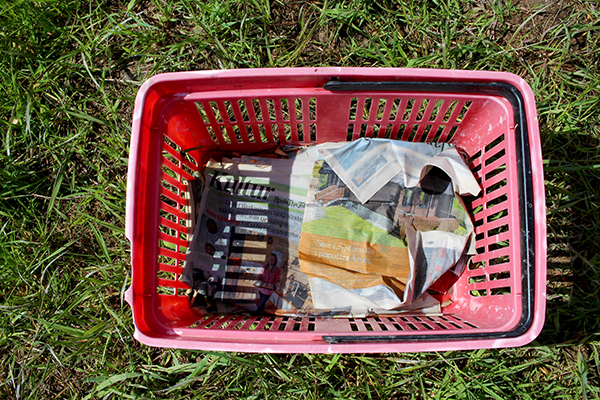I last post I wrote about the benefits of the cover of newspapers or cardboard to get rid of weeds and give the desired plants in forest garden to a good start. I have long assumed that the ink in the newspapers (and for corrugated board) is harmless and has been using newspapers as mulch for years, but I have never checked out thoroughly what substances are actually used in printing ink.
In order to finally clarify the matter, I contacted the company Bold Printing, which is one of the largest printing groups. So wrote the: ”The ink consists only of mineral oil and pigments to color the colors and charcoal black color. None of this will affect the cultivation or be unhealthy for you, but you can safely continue using newspapers.”

It sounded good I thought until I saw a newspaper notice that it had found dangerously high levels of aromatic hydrocarbon compounds (Mineral Oil Aromatic Hydrocarbons, MOAH) in cosmetics that is based on mineral oil. MAOI's a motley crew of carbon compounds, some of which are carcinogenic. Some of these substances have been investigated in the isolated state, but no one knows what a mixture of these are doing with our bodies. We take up MOAH both by mouth and skin, and the main sources of what we take up the food and cosmetics [1]. The food will MOAH mostly from packaging materials, partly by impurities in the material (often recycled paper), partly by ink emit MOAH which then end up in the food (mainly dry products with a long shelf life as pasta, ris, crispbread, etc.) [2]. While pesticide residues and emissions that sticks to the food we eat are sources of MOAH in food. MOAH formed mainly by poor combustion of petrol and diesel and also in lubricants.

When I read about MOAH it turned out, moreover, that they are degraded by oxygen and UV light and they degrade only slowly in the soil [3]. It sounded so good given how I use the newspapers and I sent a supplementary question to the printers. The answer came quickly, and read as follows:
”Color contains about 35% mineral oil. A newspaper page contains perhaps a quarter of a gram of paint. Thus, approximately 0,09 g of mineral oil per side. The oil itself contains [aromatic] hydrocarbons to a certain percentage, Saj 15. The amount will then be approx 0,018 g/sida. Compared with a motorized lawn mower emits over time is negligible course.”
With these figures, one can calculate that a standard magazine with 40 pages containing 0,72 g aromatic hydrocarbons. The comparison figure is that today we have in us 0,0036 g MOAH through diet per day, which is considered by experts to be already too much [1]. A newspaper thus contains 200 times as much MAOI that we ingest through diet every day. The risk that plants take up MOAH however, is low, then MOAH is primarily fat soluble and plants primarily deals with subjects that are water soluble. However, they can accumulate in the soil over time if you continue to bring in faster than they break down.
What is the conclusion then? The amount MAOI we will have in us from the newspapers is very small. In the short time our fingers come into contact with any microscopic amounts of ink time it does not happen so much. It's probably dangerous to read newspapers than to cover them *. This applies, however, to remember that we are in the forest gardening should not see newspapers as a long-term solution, but instead we will endeavor to as quickly as possible to get to a living ground cover that can survive without our constant intervention.
From a broader perspective, it's not newspapers that are a problem, but we let mineral oil coming into contact with the food we eat, both through packaging, exhaust fumes and pesticides. Can we get to the functioning forest gardens (with or without the help of newspapers) providing us with some of our food and where we do not use fossil-powered tools or chemical pesticides, we can get a few steps closer to a poison-free society. Otherwise, it is that we make wise choices when we consume, by buying goods in bulk, by buying as much organic as possible and by not using fossil-based cosmetics.
Sources:
[1] https://www.test.de/Mineraloele-in-Kosmetika-Kritische-Stoffe-in-Cremes-Lippenpflegeprodukten-und-Vaseline-4853357-0/
[2] http://www.efsa.europa.eu/fr/search/doc/2704.pdf
[3] https://en.wikipedia.org/wiki/Polycyclic_aromatic_hydrocarbon
*You wrapping your apples in the newspaper to increase their durability, however, should perhaps find a different method.



but then we will no longer lower the papers in the pond, but throw water and newspaper in a bucket instead. or do you think it does nothing for the life of the dam?
The disgusting substances in the newspapers is not water soluble, so it should be quiet. But you have a good point there, that one probably should not dip the newspapers in water with life ii any case,, but put them in a bucket or barrel and pour away the water instead. Bara för att vara på den säkra sidan 🙂
Interesting posts – især efter lige at have tilbragt en hyggelig dag i blæsten med våde aviser 🙂
Made me think about the following: What if you used newspaper without pressure? It must indeed so and buy – and gives it meaning? If the mulch yet to be purchased, why just buy newsprint – there are other products, providing as much sense as field mulch, or perhaps even better?
I googled for prices of newsprint, and then fell over an article about, newsprint (Thus WITH pressure) in the global market for waste paper for recycling is a much sought-after commodity, where prices are actually rising. Denmark exports among others used newspapers to Sweden, where newsprint is recycled. I guess, at det ikke er som markdækningsmateriale 🙂
So if the argument for using newspapers for field coverage, that it would be reasonable re-use of a resource, that would otherwise be lost, so keep it therefore not.
So a question: why is it just newspapers, we use to mark mulch?
This applies to Swedish newspapers who are younger than 25 years approximately. Before that, it must be available studies of newspaper printers who became fathers to a higher proportion of girls than average due to the printing ink. But here we are talking about a group that received an extreme exposure. But the old magazines I had let go of recovery.
Thanks for the great comment! We never use old newspapers for the same reason, then there were all sorts dangerous in ink, much worse than today.
Thanks for the interesting commentary! I guess we use newspapers to those of us is free to use and because they are so effective at covering the soil while adding organic matter to the soil. From a broader resource perspective, it might have been better if the papers had been recovered further sometime before we put them out. At the same time, the question is what we should use as mulch instead? All there is to use've any kind of ecological footprint and the newspapers have a guess, a rather small one. Interesting idea of buying unprinted newsprint in rolls. It sure would be great as cover material. Another option is hampaväv I think Martin Crawford uses. It combines the newspapers and advantages plastmarkvävens, but unfortunately quite expensive. What did you find the price of unprinted newsprint anyway?
135:- for 286 meter (0,57 brett) på At Work. Finns risk för föroreningar även i otryckt papper tro eller kan man tryckt förlita sig på att det är OK:-)?
Om pappret är återvunnet kvittar det tyvärr om det är tryck på eller ej. Gifterna som finns i tryckfärgerna går inte att få bort i återvinningen enligt en kursdeltagare jag hade för ett par år sedan. Hon jobbade i pappersbranschen och verkade ha bra koll. Kemikalierna ackumuleras mer och mer i materialet med tiden.
Tack, så makulatur är alltså återanvänt tryckt papper då. Då får man väl leta efter färskt papper i så fall. Finns det fallgropar där också?
Thanks for the detailed analysis of newspapers and corrugated cardboard as mulch.
But what breaks down the unnatural substances in the soil, microorganisms. To add to microorganisms type efficient microbes EM as Professor Higa developed in Japan, and you have a method that better break down the harmful substances. They also break down agricultural chemicals and medicine residues. Also accelerates the half-life of cesium. Google it, or read the book “An Earth Saving Revolution”.
If you use EM as is probably safe handling?
There is an English company (will not remember the name) which manufactures highly specialized bakteriemat, and who can do almost amazing things with the naturally occurring bacteria! When a certain pollutant is released into the wild, so there is usually already a bacteria that can eat this pollution. Company bakteriemat fatten those very bacteria that you want to have the upper hand, the second.
T.ex. they can reduce a large container with slaughterhouse waste to a charred residue on somebody today, or so — all by supplying the correct type(is) of bakteriemat! Temperatures around 200 ° C are created using only the bacteria that were already in place, but that was too few to make a difference.
Note that you can not therefore adds some bacteria, but one fattens the ones already in place in a very small amount.
Anders Holmgren in Natural Water (
naturligvattenrening.se) know more. He gave a very interesting talk about this (bl.a.) i Stockholm i mars 2013. He could certainly tell us more. Tel: 044-7770420OBS! I have no financial interest in his company, but is only impressed by the technology.
I have no forest garden, does not fit, but it is tremendously interesting to read your texts. always get ideas, thoughts and knowledge. Tack!
Thanks for the nice feedback!
Good posts! I also thought of this, but not researched it. If it is only organic compounds that are the problem there is no risk that it is in the crop, plants take well not up carbon from the ground at all? However, there can be problems if it accumulates in the soil as you type. What do you think about the degradation rate? Are all MOAH compounds degraded when the papers are degraded? Or necks we are several years?
Unfortunately, I do not know how fast degradation rate is. I found a study which had been added bacteria to speed the breakdown and there stood the breakdown generally occurs slowly, but I seem to have lost the trial now. However, I would guess that MOAH compounds are degraded after a few years, it's still very small quantities it is about. Please contact us if you encounter any more study on this!
interesting, but the pigments which? What does the? Often there are metals in the pigment. I usually add one newspaper page in the bottom of the compost bucket and have long wondered if there might be foolish in the long run.
Det blir nog ett inlägg om det också så småningom 🙂
Now there's a post about the pigments!
Googla på gifter i papper eller kemikalier i papper. Det handlar inte bara om tryckfärgen. Det går åt en massa kemikalier inom massa- och pappersindustrin för att framställa papperet och för att rena returpapper också.
När vattenlevande indikatorarter dör av att ligga i lakvatten från ett kaffefilter så lär väl detsamma hända med jordens mikroorganismer, om man täcker den med tidningar.